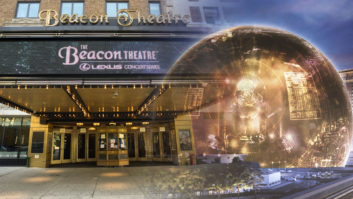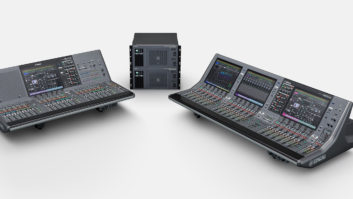Los Angeles, CA—Dave Henszey has done a lot during his 40-plus years in the pro audio industry, from running his own music studio to mixing for nearly every application from live sound to broadcast. Now, as momentum builds behind immersive music releases, he’s opened Henszey Sound, a recording and mixing facility overlooking Universal City in Los Angeles that is fully outfitted for Dolby Atmos as well as stereo work.
Earlier this year, in a major boost for immersive music, Universal Music Group announced that it would be releasing “thousands of songs” in Dolby Atmos that had been remixed at Capitol Records and Abbey Road Studios. The general catalog of Dolby Atmos music is growing steadily, with releases, principally on Blu-ray, from artists including Kraftwerk, R.E.M. and Mumford & Sons.
While a hit album can now be fully produced in a bedroom, it’s trickier to work at home in Dolby Atmos. Happily, says Henszey, who had been working out of a private studio, Dolby has made it possible for engineers to set up an affordable Atmos room in a commercial building and still turn a profit. “It’s really hard to set this up in your living room and make it work. You could use small speakers, but it’s not a laptop kind of thing.”
Henszey found a move in-ready room with suitable dimensions for Atmos work in a building that has long housed production facilities. He had L.A. sales, design and integration company Westlake Pro put his new facility together, with support from Dolby. The space is roughly three-fifths control room and two-fifths live room, and is set up for vocal, guitar and keyboard tracking. “As a quality-of-life thing, I decided not to set this up for doing drums,” he laughs.
Related: Karen O, Danger Mouse Capture Album Creation with Immersive Documentary, May 24, 2019
Then there’s the issue of certification. Dolby has been enthusiastic about certifying small rooms under its Atmos for Home program, but the spec wasn’t quite nailed down when Westlake began his build-out. “We knew that certification was on its way, but it didn’t come until more recently—and we got the first one,” reports Henszey. He also sought certification from the Trusted Partner Network, a joint venture of the MPAA and CDSA (Content Delivery & Security Association) that ensures content security.
Reb Bradford, pro audio sales manager at Westlake Pro, and Dolby recommended that Henszey consider larger-model ADAM Audio speakers for LCR to better match the surround and upper speakers, and he’s glad he listened. “The EQ characteristics are more similar to the rest of the speakers,” says Henszey, who has A77Xs for LCR, four A7X surrounds and four A5X overheads, with twin Sub12s. Even though the project was already underway, Bradford also advised waiting for Dolby to release a Mac version of its Rendering and Mastering Unit (RMU).
Henszey pays attention to details: The front edge of the raised client seating area is drilled to act as a bass trap. There is a 7-inch block of foam beneath the couch. He had TubeTrap build custom bass trap monitor stands the exact width of the rear speakers. Even the Argosy LCR speaker stands have custom-cut bass-trapping foam inserts.
He opted for a Slate Raven MTI workstation running Avid Pro Tools Ultimate 18 loaded with plug-ins and supplemented by outboard gear from Universal Audio, Rupert Neve Designs and others, including the new SSL SiX. Focusrite RedNet boxes support Dante-networked audio distribution.
Related: This Immersive Concert Put Everyone to Sleep—On Purpose, by Steve Harvey, Aug. 1, 2018
A BSS box manages monitor switching and reconfiguration, allowing Henszey to work in Dolby Atmos or 2.0. Whether with an original production or a catalog remix, “I get it working in stereo, then I break it out,” he says. That way the hard work gets done first. “By the time you kick it into an Atmos mix, the client’s not spending the money—because it’s more than four times the rate. It makes Atmos approachable for people who otherwise wouldn’t be able to afford it.”
Henszey started out working on big band and classical projects in his native Wisconsin, then opened his own studio in 1988, AD Productions, the first Midwest facility to install a Neve V series desk. The studio attracted clients such as Jerry Harrison, Cheap Trick and Violent Femmes. After moving to Los Angeles in the ’90s, he worked extensively at Cherokee Studios with producer Andy Johns and with artists including George Clinton. He has also mixed front-of-house on arena tours by the likes of Destiny’s Child, Brandy and Jamie Foxx, plus numerous acts for late-night television.
For all his experience, Henszey is still learning new things as he works in Dolby Atmos. “As soon as I think I know everything, I’m screwed,” he says.
For instance, he’s learned that with EDM, any rhythmic elements that need to be in sync should not be panned far apart because the track will likely be played back in a much larger room. That said, he bleeds a little kick drum into the side channel: “If it’s a nice sounding kick, it goes around you a little bit, but it also gives you a lot of energy without the speakers crapping out.”
Pointing to the project on which he is working, Henszey says, “On this track I have a vocal stem with some doubling, but I grabbed a copy of the raw vocal, nice and warm, with sizzle. I can push a little bit into just the center speaker, so no matter what ends up happening around the room, the vocal is still there—and anything with bass on it doesn’t get that center speaker.”
Want more stories like this? Subscribe to our newsletter and get it delivered right to your inbox.
As soon as an Atmos mix is done, the client will often post a binaural version to YouTube, he reports, “so the first thing I’ve got to do is check the binaural render.” Henszey favors the Near setting in binaural rendering mode: “Near is maximum imaging for headphones, but if you’re playing it on speakers and you use Near, it sounds good enough and tight enough without having to listen on headphones.”
Dolby and Westlake collaborated on a piece of software that enables him to manage the speakers and switch sources on a tablet—checking the mix in 7.1 or 5.1, for instance. One button routes the stereo mix through processing to emulate a premium car system, complete with boosted treble and bass. “You’d better hear it that way because that’s how people are going to listen,” he says.
You might call immersive music the Engineer Employment Act of 2019. “The one place where clients really need you is when you’re doing something like this,” says Henszey.
Henszey Sound • www.henszeysoundllc.com





